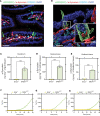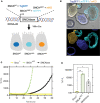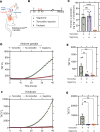Gut mucosal cells transfer α-synuclein to the vagus nerve
- PMID: 38063197
- PMCID: PMC10795834
- DOI: 10.1172/jci.insight.172192
Gut mucosal cells transfer α-synuclein to the vagus nerve
Abstract
Epidemiological and histopathological findings have raised the possibility that misfolded α-synuclein protein might spread from the gut to the brain and increase the risk of Parkinson's disease. Although past experimental studies in mouse models have relied on gut injections of exogenous recombinant α-synuclein fibrils to study gut-to-brain α-synuclein transfer, the possible origins of misfolded α-synuclein within the gut have remained elusive. We recently demonstrated that sensory cells of intestinal mucosa express α-synuclein. Here, we employed mouse intestinal organoids expressing human α-synuclein to observe the transfer of α-synuclein protein from epithelial cells in organoids to cocultured nodose neurons devoid of α-synuclein. In mice expressing human α-synuclein, but no mouse α-synuclein, α-synuclein fibril-templating activity emerged in α-synuclein-seeded fibril aggregation assays in intestine, vagus nerve, and dorsal motor nucleus. In newly engineered transgenic mice that restrict pathological human α-synuclein expression to intestinal epithelial cells, α-synuclein fibril-templating activity transfered to the vagus nerve and dorsal motor nucleus. Subdiaphragmatic vagotomy prior to induction of α-synuclein expression in intestinal epithelial cells effectively protected the hindbrain from emergence of α-synuclein fibril-templating activity. Overall, these findings highlight a potential non-neuronal source of fibrillar α-synuclein protein that might arise in gut mucosal cells.
Keywords: Gastroenterology; Neuroscience; Parkinson disease.
Figures





Update of
-
Gut mucosal cells transfer α-synuclein to the vagus nerve.bioRxiv [Preprint]. 2023 Sep 5:2023.08.14.553305. doi: 10.1101/2023.08.14.553305. bioRxiv. 2023. Update in: JCI Insight. 2023 Dec 8;8(23):e172192. doi: 10.1172/jci.insight.172192. PMID: 37645945 Free PMC article. Updated. Preprint.
References
Publication types
MeSH terms
Substances
Grants and funding
LinkOut - more resources
Full Text Sources
Medical
Molecular Biology Databases
Research Materials
Miscellaneous

